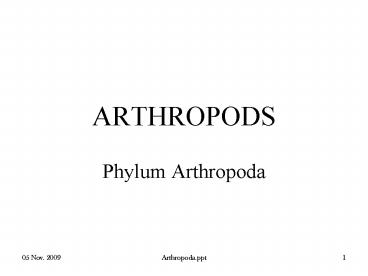ARTHROPODS - PowerPoint PPT Presentation
1 / 36
Title:
ARTHROPODS
Description:
Abandoned hydrostatic system of annelid-like ancestor) Coelom reduced to pericardial cavity ... system resembles that of annelid. Dorsal brain with nerves ... – PowerPoint PPT presentation
Number of Views:79
Avg rating:3.0/5.0
Title: ARTHROPODS
1
ARTHROPODS
- Phylum Arthropoda
2
Phylum Arthropoda (jointed feet )
- Huge group, gt 1,000,000 species.
- estimate 1,000,000 spp. arthropods
1,190,000 spp. animals - 84 of all animal species are arthropods!!
3
Phylum Arthropoda
- How can we explain the success of the arthropods?
- Exoskeleton!
4
Phylum Arthropoda
- Exoskeleton of chitin and protein ( cuticle)
- structure
- epicuticle (oily, waxy)
- exocuticle (chitin protein)
- endocuticle (chitin only)
- epidermis secretes cuticle
5
Problems associated with exoskeleton.
- Problem 1. MOVEMENT
- Solution Joints in exoskeleton.
- arthro-, joint
- -pod, leg, foot
- Exocuticle absent from joints may form hinges.
- Endocuticle alone allows flexibility.
6
Problems associated with exoskeleton.
- MOVEMENT
- Solution Joints in exoskeleton.
- Exocuticle absent from joints may form hinges.
- Endocuticle alone allows flexibility.
7
Problems associated with exoskeleton.
- Problem 2. GROWTH
- Solution Molting
8
Molting (1)
- Secretion of "molting fluid" to dissolve old
endocuticle.
9
Molting (2)
- New cuticle formed under old exocuticle.
- Break out of old cuticle
- Old cuticle breaks at line of weakness
10
Molting (3)
- Inflate with water/air to increase size while
skeleton soft, - but soft skeleton gravity limit size
- arthropods are mostly small.
- Hardening of new exocuticle.
11
Growth stages
- Arthropod passes thru 3-20 growth stages in
life cycle. - Some stop molting as adults (insects, most
spiders) - Some continue to molt (crayfish, tarantulas)
12
Problems associated with exoskeleton.
- Problem 3. SENSORY INPUT
- touch
- sensory setae connected to neurons
- smell taste
- hollow sensory setae w/ chemosensitive nerve
endings
13
Problems associated with exoskeleton.
- Problem 3. SENSORY INPUT
- vision
- clear cuticle over compound or simple eyes
14
Problems associated with exoskeleton.
- Problem 3. SENSORY INPUT
- hearing
- tympanum endocuticle, vibrates like eardrum
- trichobothria (right ?)
15
Benefits of Exoskeleton to individuals
- Support
- Locomotion
- lever system
- walk, swim, fly
- Mechanical protection (armor)
- Retards evaporation (in air) and/or osmosis (in
water) - water balance.
16
Benefits of Exoskeleton to the phylum
- Reduction of coelom segmentation
- Abandoned hydrostatic system of annelid-like
ancestor) - Coelom reduced to pericardial cavity
- Segments fused tagma, tagmata
- Tagmosis
- Specialization of body regions ( tagmata)
- Specialization of appendages
17
Tagmosis
- Head ( 4-6 segments)
- feeding, sensation
- Head appendages
- mandibles,
- maxillae,
- maxillipeds,
- chelicerae
- antennae
18
Tagmosis
- Thorax ( 3-6 segments)
- locomotion, grasping.
- Thoracic appendages
- walking legs,
- wings
- chelipeds
19
Tagmosis
- Abdomen (8- 30 segments)
- respiration, reproduction, etc.
- Abdominal appendages
- abdominal gills (aquatic insect larvae)
- swimmerets (crayfish)
- filtering legs (barnacles)
- gonopods (crayfish, etc.)
- spinnerets (spiders)
20
Tagmosis
- Number of segments/legs in each tagma varies by
subphylum, class. - Cephalothorax of 6 segments in Chelicerata
- 1 pr. chelicerae
- 1 pr. pedipalps
- 4 pr. walking legs
- Cephalothorax of 13 segments in Crustacea
(shrimps) - 2 pr. antennae
- 1 pr. mandibles
- 2 pr. maxillae
- 3 pr. maxillipeds
- 5 pr. walking legs (1st pair modified as
chelipeds)
21
Other arthropod characters
- Open circulatory system
- Dorsal heart pumps hemolymph over brain
- Hemolymph moves through hemocoel back toward
heart - Ostia (holes) in sides of heart let hemolymph in
to go around again.
22
Other arthropod characters
- Respiratory systems
- Gills in aquatic/marine arthropods
- Tracheal systems in most terrestrial arthropods
- Book lungs (modified gills) in spiders scorpions
23
Other arthropod characters
- Nervous system resembles that of annelid
- Dorsal brain with nerves around esophagus
- Paired ventral nerve cords
- Segmental ganglia
- Often fused into 1-2 ganglia in each tagma
24
Distinguishing Characters of Ph. Arthropoda
- Jointed exoskeleton
- Tagmosis
- Compound eyes
25
Classification of Arthropoda
- Subphylum Trilobita
- Subphylum Crustacea
- Subphylum Chelicerata
- Subphylum Uniramia
26
Classification of Arthropoda
- Subphylum Trilobita
- Class trilobites
- Three-lobed head body (left, middle, right)
- Diverse in Paleozoic 540-240 MYA
- Extinct
27
Classification of Arthropoda
- Subphylum Crustacea
- 2 pr. Antennae (antennules, antennae)
- Cephalothorax
- 13 segments appendage pairs
- Abdomen
- variable among Classes
28
Classification of Arthropoda
- Subphylum Crustacea
- Class shrimps
- Class barnacles
29
Classification of Arthropoda
- Subphylum Chelicerata
- Cephalothorax
- Jaws are chelicerae
- Pedipalps
- 4 pr. Walking legs
- Abdomen
30
Classification of Arthropoda
- Subphylum Chelicerata
- Class Horseshoe crabs
- Horseshoe crabs
- Scorpions ??
31
Classification of Arthropoda
- Subphylum Chelicerata
- Class Arachnids
- Lost compound eyes
- Spiders
- Daddy-long-legs
- Amblypygi
- Mites ticks
- more
- Scorpions ??
32
Classification of Arthropoda
- Subphylum Uniramia
- Legs unbranched
- Class Centipedes
- 1st legs are fangs
33
Classification of Arthropoda
- Subphylum Uniramia
- Class Millipedes
- Double segments (2 pr. legs per segment)
34
Classification of Arthropoda
- Subphylum Uniramia
- Class Insects
- Head, thorax, abdomen
- 2 pr. Wings
- 800,000 species, majority of all arthropods
35
Why are Arthropods so successful?
- Exoskeleton ? tagmosis ? evolution of flight ?
speciation ? 106 species of insects.
36
Why are Arthropods so successful?
- Exoskeleton ? protection from water loss ? early
colonization of land ? head start. - Arthropods were diverse and widespread on land
before vertebrates!































